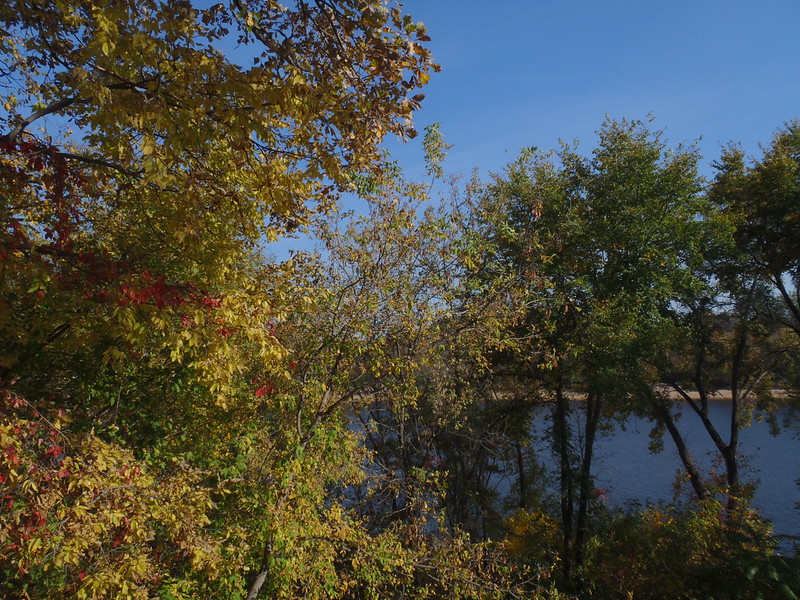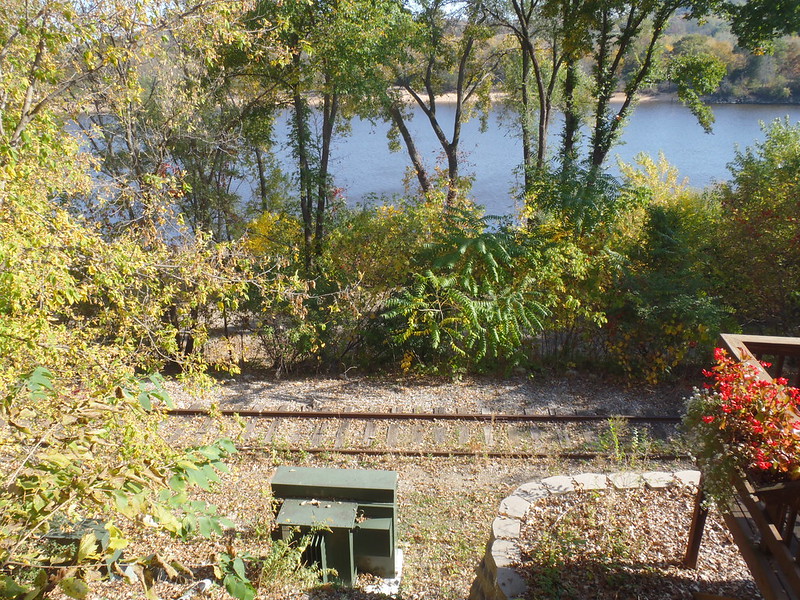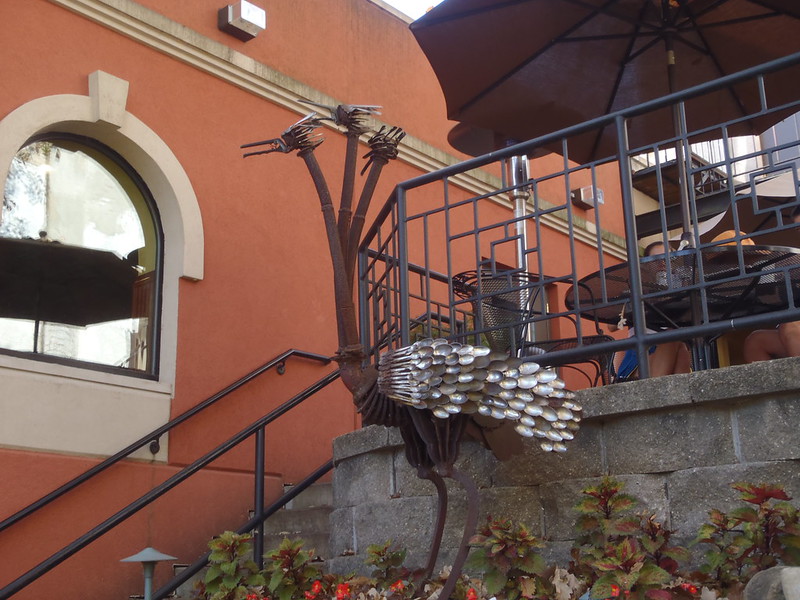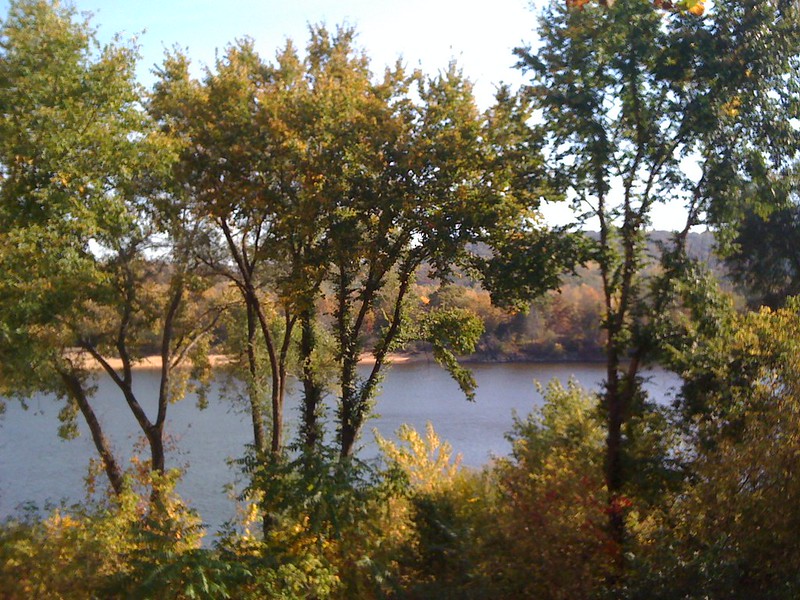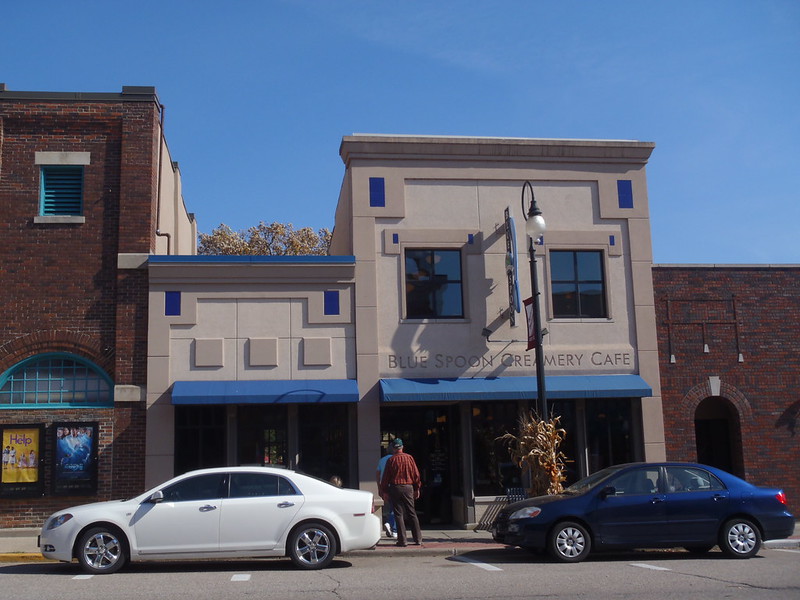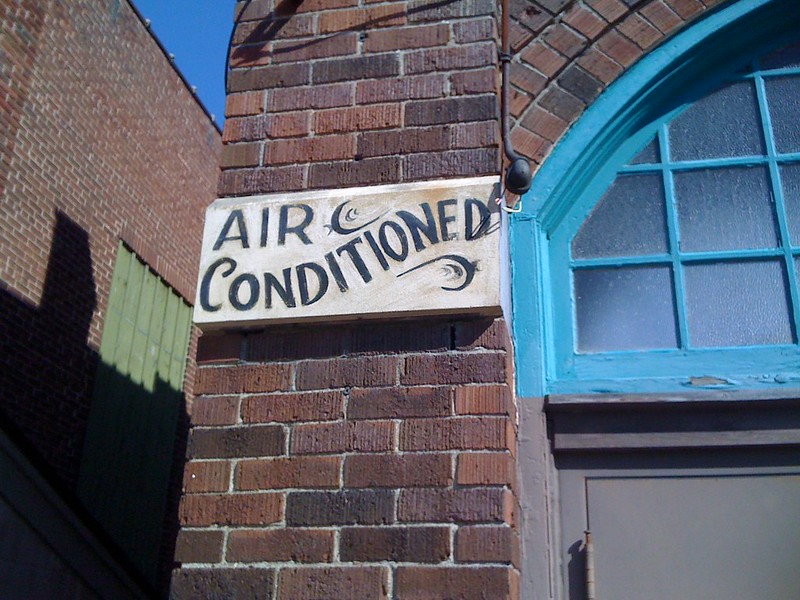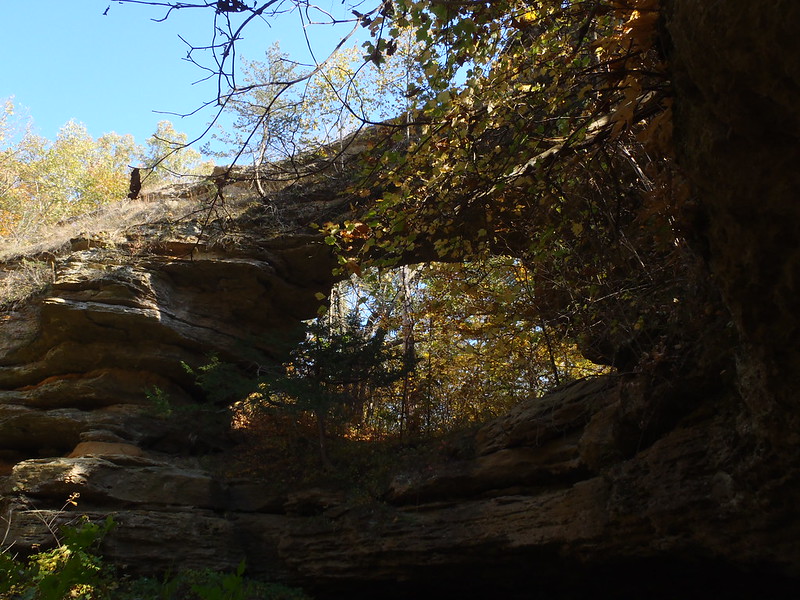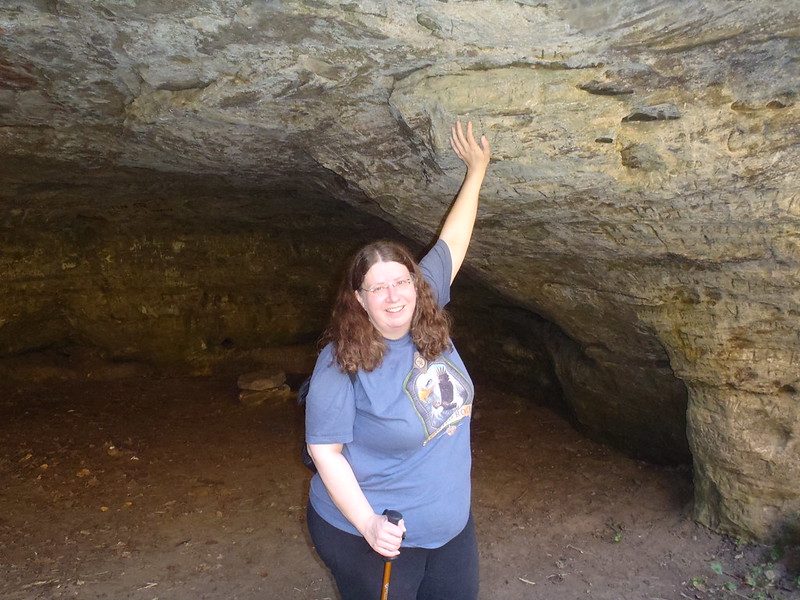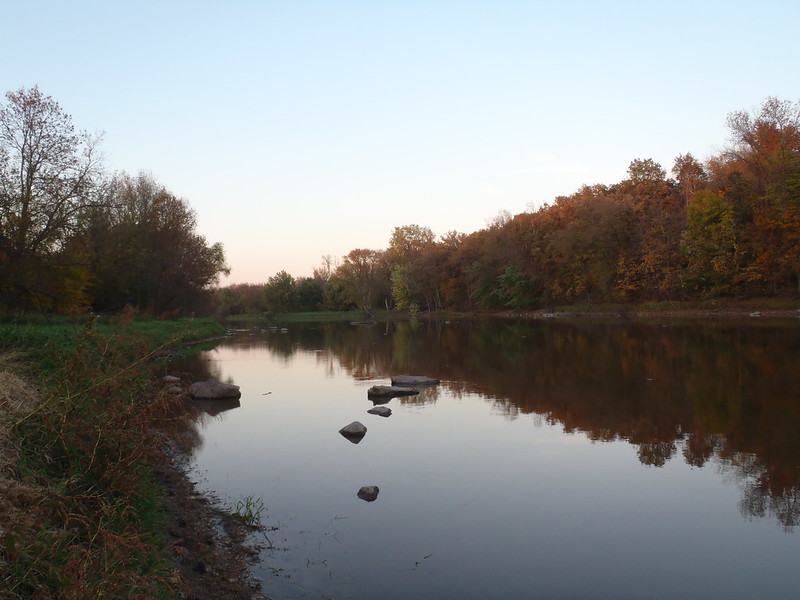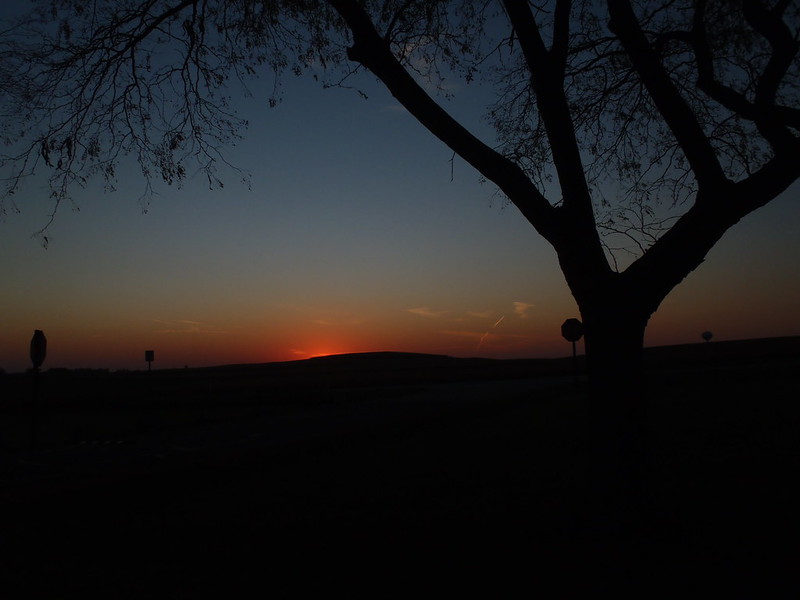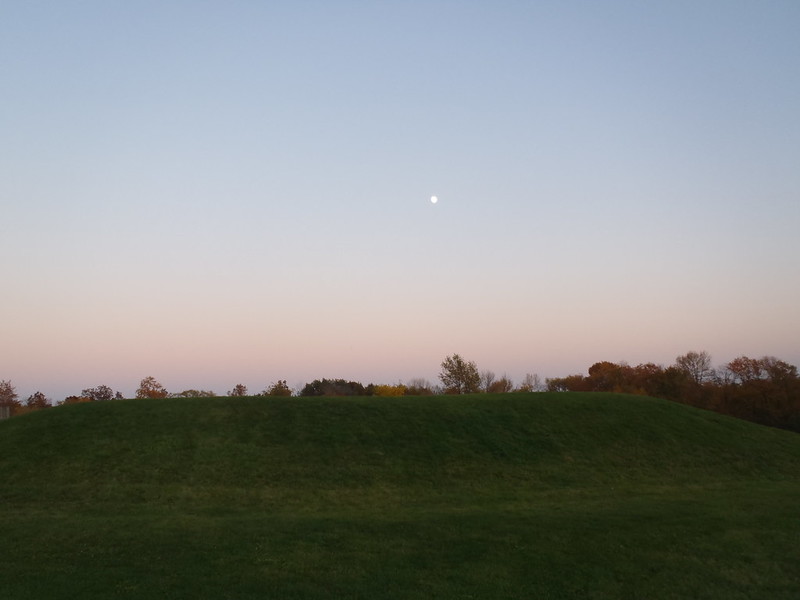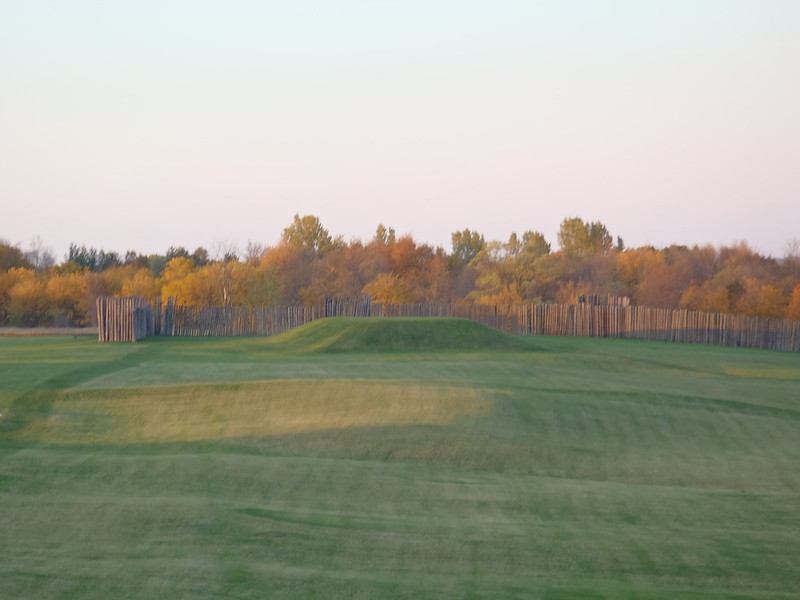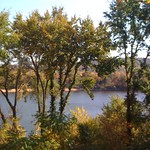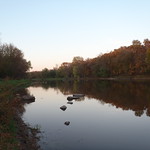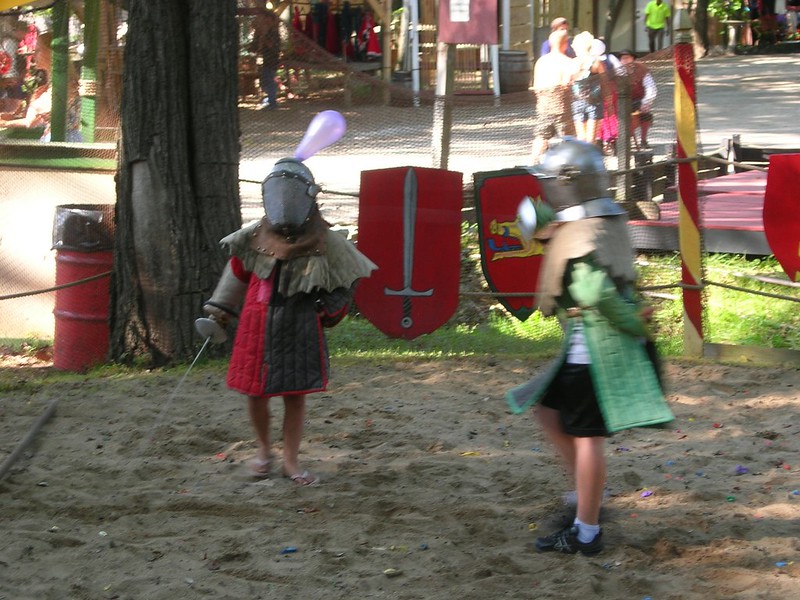Tag Archives: Wisconsin
Blue Spoon Cafe, Natural Bridge and Aztalan State Parks, Wisconsin
More adventures in America’s Dairyland, October 8, 2011
During our first trip to the Baraboo area of Wisconsin, J. bought a $35 state park permit that expires at the end of the year, so use it he must. That’s why we ended up on I94 to Wisconsin again, this time centered on the Prairie du Sac/Sauk City area.
Thanks to Yelp for iPhone, on Saturday morning we landed at the Blue Spoon Creamery Café, where you order and get a number, and your meal is delivered to your table. While J. stood in the short line, I sought the outdoor seating that I’d read about — Blue Spoon has three terraces overlooking the Wisconsin River, and I found a perfect spot on the middle terrace, with lovely views of the river and the railroad tracks.
Railroad tracks?
Railroad tracks run between the lowest terrace and the river, but, judging from the height of the weeds between the rails and the nonchalance of those who strolled by occasionally, they seem to be abandoned — a perfect Rails-to-Trails Conservancy project. Somehow the rails added to the scene’s interest. I wondered when a train last rumbled behind all those buildings on Prairie du Sac’s main street.
After lingering for a long time over breakfast and coffee — who wouldn’t in such a perfect spot and in such perfect weather? — and getting coffee beans to go, we stopped at a tiny farmers market on a lot between two buildings across the way. Because of its size, the offerings were slim but surprisingly varied, from produce and cereals to jewelry and a locally roasted coffee. Which meant more coffee. I have enough to start a small business.
The next stop was next door at the J. S. Tripp Memorial Museum. The Tripp has a large collection of preserved birds, donated years ago by taxidermist Ed Ochsner. It’s probably the closest I’ll get to a golden eagle, which looked like it could have carried off whole villages. It’s mostly feathers, but they make its head look almost as large as a human’s. The saddest pieces were the tiny spotted deer twins and baby ducks.
The museum features a working Royal typewriter with round keys. The proprietor told us the kids try to type on it like they would on a laptop and are surprised by the force and effort it takes to punch the keys. His view is that manual typewriters required so much movement that carpal tunnel didn’t become an issue for those pioneer typists — it’s the small, repetitive motions that cause or exacerbate CTS.
Near the typewriter is a proof press(se) with wood type, along with samples of newspapers partly in English, partly in German. In addition to photos, furnishings, clothing, knickknacks, and the like, the museum, like others of its kind, features Civil War arms and regalia. These exhibits make me think that, if there isn’t one already, there should be a database of history museum and historical societies’ holdings — not just, say, those of the Smithsonian and other large institutions. It sounds like a formidable undertaking, but with Internet communications, digital cameras, and database and other technology, along with agreed-upon standards and willing volunteers, it could be done. It probably comes down to time, money, and value. A formidable undertaking indeed.
As we were getting ready to leave, our new acquaintance pointed out a winery across the river, halfway up the hillside — another reason to consider returning.
Finally we left for the next destination, Natural Bridge State Park, getting lost a few times along the way. We did pass a few cows here and there, but not as many as I might have expected in America’s Dairyland. I’ve seen more in New York and Pennsylvania, albeit in spring and summer.
At Natural Bridge State Park, we saw a middle-aged couple returning from the trail and asked them how far to the bridge. The man answered in time, not distance, saying it was about five minutes away and telling us that they’d learned there’s a cure for everything in plants (signs along the trails indicate how Native Americans used various plants medicinally). His tone was at the advanced end of skeptical. He must not know where aspirin and quinine come from.
An hour plus later of slowly climbing up a long, steep, eroded trail and stairs to an overlook and taking many photos, we were skeptical of his five-minute estimation. After a while, we ran into people evidently on the return trip who told us the bridge wasn’t much farther. I was at a point where I wondered if I could get back down the steeper, narrower parts of the trail, or if I was going to have to be carried or, more likely, airlifted out. Not that this is an especially difficult trail for most people, who strolled past us on their way out, but my knees and ankles don’t appreciate the physics of even slightly steep descents, especially when the trail is narrow, tilted, or eroded unevenly. I was very glad to have worn hiking shoes and to have brought a trekking pole — I needed both.
At last we arrived at the natural bridge at about the same time as a couple coming from the opposite direction. From these people and others, we learned that the trail forms a loop and that we must have taken the longer way around. When I mentioned that my knees don’t like steeper descents, the male half commiserated with me — that’s why they’d taken the shorter, easier way.
The bridge, the largest in Wisconsin, was lovely and impressive in the afternoon sun, but it saddened me to see the silly graffiti carved into it. We’re not talking Shakespearean sonnets, just juvenile “Rick rules” and “Jordan and Jillie” type graffiti — nothing anyone wants to see now, let alone 500 or 5,000 years in the future. I’m sure this has been going on for countless generations.
After a prolonged photo session, we continued down the trail, which descended in several places, although not as sharply. After about 10 minutes or so, we could see and hear signs of the parking lot through the trees. We really had taken the long, hard way — and I’m glad we did, and that I did without complaint. I proved something to myself.
A middle-aged and an elderly woman approached us and asked a few questions. I firmly told them to veer right. I was thinking that if they went left, they would end going a really long way around another loop the trail had led to. J. was beside himself and after they left (veering right) insisted I was wrong. I realized we were talking about different splits and that he was correct — they had gone the wrong way. So I hustled after them, surprised by how far they’d already gone up the wrong trail. They were already thinking of turning back or perhaps had — I’m not sure — and I felt guilty as I watched the older woman gingerly pick her way down. I stayed in front of her so at least I could steady her if she couldn’t make it. I tried to explain my error and apologized profusely. The younger woman said they were starting to wonder and she didn’t blame me — she thought there should have been directions. We had found a sign — as we were returning. All’s well that ends well, and neither I nor the older woman had to be rescued!
Next on the list was Aztalan State Park, an hour and a half away — that is, if you know where you’re going. There were long stretches during which the cellular network disappeared, which made the various map apps useless. We did pass some points of interest, including what appeared to be a church in the middle of nowhere. According to a sign, which J. noticed in passing (twice), it was a church museum. I’m not sure it was open. It’s one of those roadside oddities that might pull you in if you have time and and an interest in the unusual.
I did break J.’s heart by insisting we bypass Rustic Road (Lane?), which might have worked as a route, and might not have. I’m convinced he’s a sucker for marketing and was hoping to find something especially picturesque on a road called “Rustic.” I thought we’d see more frame houses and tidy yards. While the rolling hills aren’t quite the equivalent of Pennsylvania’s Central Alleghenies, overall the look is similar, only neater and more affluent.
As we were passing through a small town that I thought (hoped) had to be close to Aztalan, somehow J. spotted a coffee shop called the Daily Grind. How his radar picks up coffee shops while he’s driving I’ll never know, nor do I want to know. We stopped there, ordered drinks, and crossed the threshold into the connected pottery shop.
AFter a few more miles and false turns. we arrived at Aztalan around 5 o’clock, an hour later than I’d expected. At this time, we could experience this historic site with its restored Mississippian mounds in the waning daylight. First, J. couldn’t resist spinning a wheel to power playback of an educational recording about the site, while I cranked an old-fashioned pump connected to a drinking fountain. I wasn’t thirsty, but was fascinated to witness the result of my labor come out of the fountain and the excess disappear into a drain in the earth. The water had a taste, as water close to the source often does.
It’s not something I think about often, but there is something marvelous about working and seeing the effort tangibly rewarded. As so little is left that requires labor — even the simple task of dish washing for most is delegated to a machine — I wondered if that’s part of why gardening, scrapbooking, crocheting, and other manual arts have surged in popularity in the online age. It’s physically and spiritually satisfying to create something by hand — or to tease water out of the ground. As a novelty, it felt great. If I had to do it for drinking, cooking, cleaning, and bath water every day in every kind of weather, I wouldn’t be so enamored.
We ascended a couple of the mounds, which overlook a strangely featureless landscape. It’s not flat like much of Illinois, but nothing stands out, except the mounds and palisades, and the lines of trees. Only a few visitors were about when we arrived, and the dog walker and kite flyer disappeared before sunset. Not seriously, I wondered if the local sprouts used the mounds for sledding, and J. said, “Until hand reaches out from within the mound . . .”
As the sky grew darker, the colors became less distinct, and the scene more somber. It seemed a good time to leave the mounds and their histories in peace, undisturbed.
More misdirections and an urgent stop or two at gas stations, and we were in Lake Geneva, where we had reservations at the Baker House. The fine weather continued into the evening, and people seemed to be wandering about in search of a party. At the Baker House, the atmosphere was almost busy, loud, and crazy enough for the Great Gatsby. J. was disappointed not to get a table in one of the elegantly appointed rooms, but the enclosed porch, while close to the musicians, was almost calm.
After a little walk near the lake, finally we headed homeward. Although it should have been a two-hour drive here, it took more like three to four, including a half hour nap in the parking lot of a doggy day-care center. A full, full, rewarding, and exhausting day.
Day at Wisconsin Dells
Right after a 40-hour work week and 8-hour work day, there’s nothing like a 4-hour (plus) car trip to rejuvenate the wearied mind and senses. At the end of countless miles of mesmerizing orange-and-white barrels and tags along I90 lie Baraboo, Devil’s Lake State Park, and Wisconsin Dells. The distance, about 200 miles, is nearly the same as from my old home in Hamburg, New York, to my extended family in the Altoona, Pennsylvania area. Forty years ago, with breaks for a meal and to collect mountain spring water before it became too polluted to drink, the Altoona trip took an interminable five hours. I remember well my back seat plaint of “Are we there yet?” and resisted the strong temptation to resurrect it, especially as Google Maps helpfully tracked the apparent slowness of our progress north and west, and my sciatic nerve sent searing pain down my right leg to make sure I knew it wasn’t happy.
International Crane Foundation
After a short but intense rest and a soak in a whirlpool, I was ready for the first destination — the International Crane Foundation. I knew about the ICF from my work as a docent at Lincoln Park Zoo, but somehow I’d forgotten about it. Right now, the main road leading to the ICF is closed for repairs, so we went in via County Road A. Even while getting out of the car, I noticed a number of eerie calls that aren’t in the usual repertoire of the wildlife and domestic stock typical of farm country. As we wandered and listened to some of their vocalizations, I realized how effective they could be if used in an alien invasion film.
Many of the cranes were in the middles of their enclosures, alert but not concerned about their human admirers. The Siberian crane pair, however, was at the very back, where we couldn’t get a good look at them. After a few minutes, though, they’d had a good look at us and didn’t like what they saw. First the male, followed by the female, approached us stiffly and threateningly, every posture, movement, and sound expressing displeasure. The woman in the visitors center had told us cranes are territorial and aggressive and had asked us not to intrude on their space with so much as a camera lens. We didn’t have to. We got the full show by standing quietly and behaving. After they came to the fence and put on their threat show, they remained wary but had lost the intensity of their interest.
The showcase habitat features the endangered whooping crane, whose plight I recall from childhood when only a handful remained. On one side of a pavilion, you can relax in the shade and watch a 20-minute video about them and the use of ultralights to train young birds in the ways of migration. On the other, a roomy seating area overlooks a wetlands where a pair was foraging in the water. While there is no obvious barrier, a guide said there’s a drop-off that the cranes know about.
Unlike their Siberian cousins, the whooping cranes seemed unconcerned about either us or the group on the official tour that had caught up with, then bypassed us. At first hidden behind the grasses and reeds, they waded out into the open water, approaching the seating area at times, then wandering back behind the grasses, all very nonchalantly.
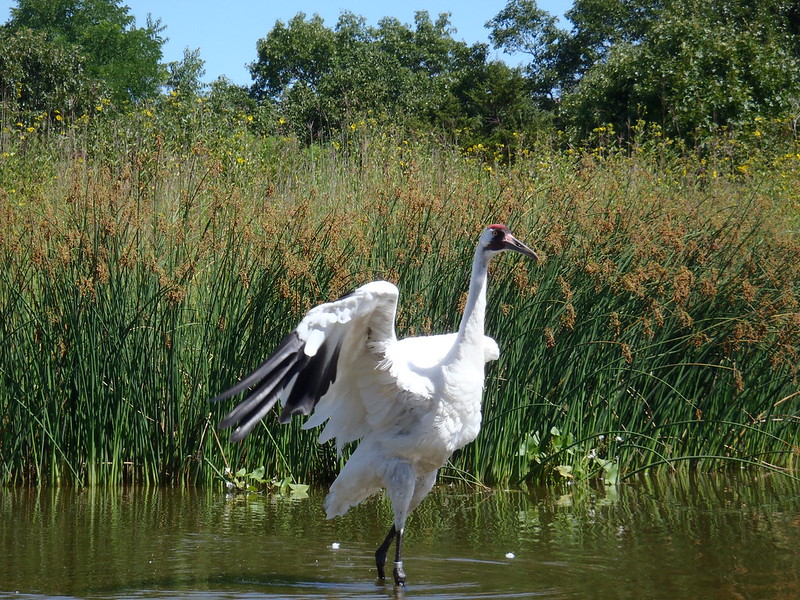
at International Crane Foundation, Baraboo, Wisconsin
I lost track of how many of the 15 crane species we saw, although it was most of them. The crane enclosures are distributed along trails bordered by a messy array of wildflowers (or weeds, if you prefer your flowers bred, hybridized, and given a cute name followed by a registration mark). Bees, butterflies, and others couldn’t get enough of what I think is gayfeather. They remind me of how much I would love to have a butterfly garden.
It was almost one o’clock when we left. The day had dawned cloudy and rainy, but by the time we’d arrived at ICF, the rain had stopped, the clouds had cleared, and the sun had made its appearance. In less than an hour, the day had transformed itself from disappointing and unpromising to perfect.
Perfect weather for a Duck. An Original Wisconsin Duck.
Original Wisconsin Duck adventure
Call me sheltered, but I’d never heard of Ducks as either amphibious military machines or tourist attraction, but they’re part of the draw to Wisconsin Dells. I didn’t have much time to read about them and didn’t know what to expect.
On the way to the Original Wisconsin Ducks, I pointed out a young man sitting on a chair next to the highway, seemingly doing nothing more than getting a tan in an especially noisy, barren spot. I wondered that he couldn’t find something better to do and a better place to do it. It turns out he was working. More about that in a bit.
Also by the roadside, we noticed signs indicating one-way Duck trail — and soon spotted an actual Duck lumbering down the trail and stopping to wait to cross the highway. That was my first glance of a Duck and how they operate. It wasn’t long before we found its home base.
Each Duck seats 20. When one fills up and drives off, another takes its place. We were near the head of the line when an empty Duck arrived. The few people ahead of us conservatively sat in the middle seats, perhaps afraid of getting wet, but I pushed J. to the front right-hand seat. From here we could see the Duck’s dashboard, with exposed crossed wiring. The war industry had no time or use for aesthetics or niceties. We could also see a control for bilge water. That, the life vests overhead, and the overall shape of the Duck were the only indications from inside (on board?) of the vehicle’s amphibious nature.
Time to board! I’d told J. driving (piloting?) a Duck could be the perfect retirement career for him, but it looked like fairly hard work to manipulate all of the mechanics while trying to elicit laughter for a series of corny jokes. We learned later that Duck drivers are college students who undergo six weeks of training. No Duck for J.
Into the dells we went, including Fern Dell, where the already pleasant temperature dropped several degrees. The combination of rocks and trapped moisture on which the ferns thrive acts like a giant air conditioner. With the play of the sun and shadow, the rocks, the lush green of the trees and ferns, and the brisk air, I thought I was in heaven — except, of course, for the roar of the Duck’s engine, which kept me grounded. So to speak.
With a splash and spray that made me happy I’d steered J. to the front seat, the Duck entered the Wisconsin River with its amazing sandstone bluffs. With the woods, water, and bluffs, I could be happy living here, I thought, even as bigger, faster boats jetted by and set the Duck to rocking.
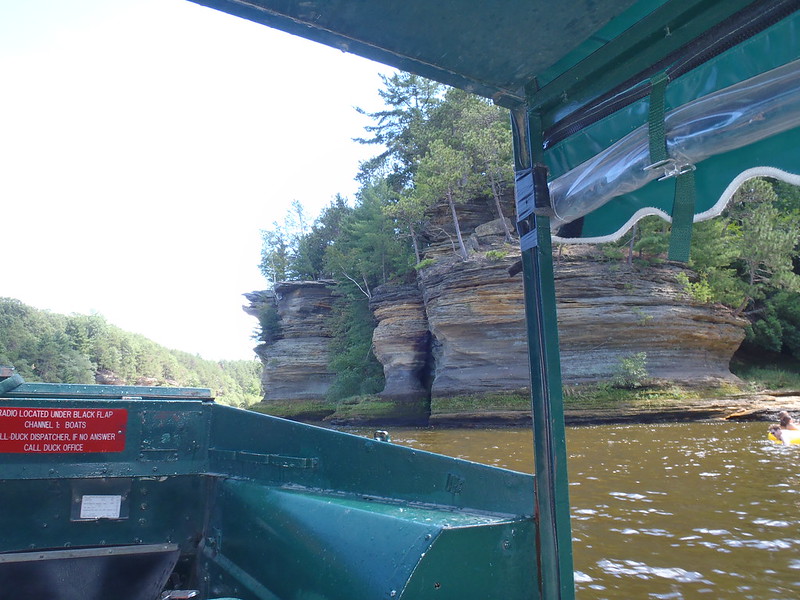
Between corny jokes, our driver/helmsman pointed out where in 2008 heavy rains had raised the level of Lake Delton, causing it to rise and break through a weak spot and to empty into the river, taking several houses with it. I remembered seeing video and the concern about what was to be done and whether the area could recover. Lake Delton refilled quickly and on this calm day little resembling the raging torrent of rushing, roiling water in the video. The bank opposite the breach shows how high the river rose when all that lake water suddenly poured into it; the earth looks like it was hit with force and churned quite high above our heads. For the observers, it must have been both a frightening and an awesome experience (in the true sense of that overused expression).
After a leisurely cruise on the river, the Duck clambered over a sand bar into Dell Creek. Next we entered Lake Delton, which was full of vacationers, tourists, and locals. The dire predictions didn’t come true, and people like us continue to pour in and pay to enjoy the river, the lake, and the dells. I often wonder about the many situations that seem bad in the present, but worked out okay or even well in the long term. For all the gloom and doom I grew up, many things today are better or at least no worse. For example, the Great Lakes may be threatened by zebra mussel and Asian carp, but they’re cleaner than they were when I was a child wading among clumps of slimy algae at Hamburg Beach. And, we’re making the effort to save species like the whooping crane rather than let them follow their cousins the dodo and the passenger pigeon into oblivion.
Back on land, the driver stopped twice to talk to young men sitting along the Duck trail. The first proved to be the idle fellow I’d pointed out from the highway. Our driver asked him about his Barbie doll order and other fetishes and told us to wish the other guy a happy birthday. He said they earn $20 an hour for sitting around. My guess is that they’re Duck spotters, paid to coordinate the movements of the many Ducks on land. Where were these cool summer jobs thirty years ago in western New York?
On the return trip, the Duck passes through a couple of narrow gorges, Red Bird and Black Hawk, with only four inches leeway on either side. I was tempted to reach over and try to touch the rock. We also stopped to admire a few deer dining just off the trail. “They’re so lifelike, aren’t they?” our driver said. One even drooled happily. It was then someone noticed the deer had companions — up to a half dozen wild turkeys. I said something about the convenience. Our driver peered thoughtfully and said, “It’s amazing what they can do with electronics.”
Near the end of the tour, he stopped the Duck to pass out booklets and postcard packets, explaining that Duck drivers are students (sorry, J.) and that through a program they earn the money from the booklets and postcards we tourists buy from them (guilt trip!) for $2 apiece. What a deal! J. had his wallet out immediately. Someone asked where he was going to college; he answered, “Boo U.” Someone scoffed at the name, so he told us that it’s the nickname for Baraboo University — I guess the scoffer hasn’t heard of cutesy college nicknames! Someone asked a tough question: “What are you studying?” judging by his embarrassed reaction. He confessed that he hadn’t actually started college; he had just graduated from high school. As we were about to exit, I couldn’t resist asking him if he even has a driver’s license. “Yes,” he informed me, probably praying I wouldn’t pinch his cheek. “I have a commercial license.” Well, at 18 he’s at least two up on me — I’ve driven neither car nor Duck!
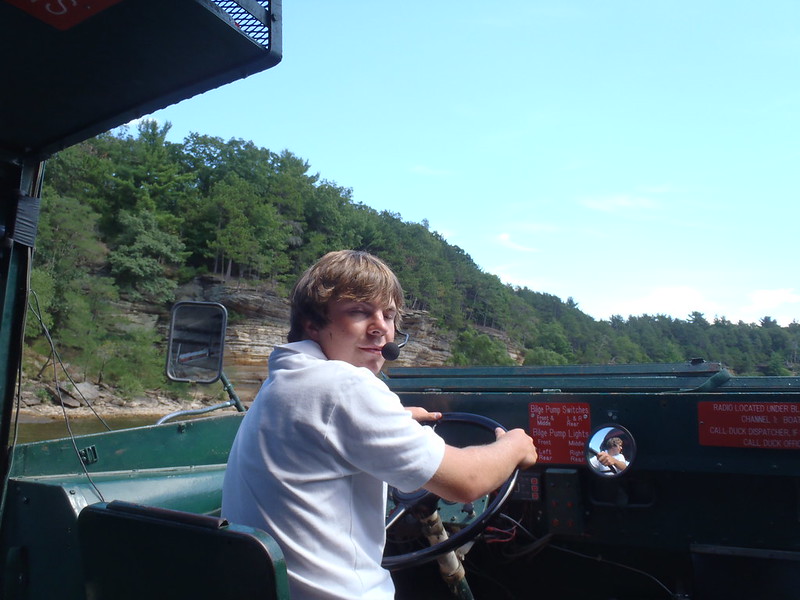
The Cheeze Factory
Our next planned destination was Devil’s Lake State Park, but as we drove through the area admiring the updated, upscale 1950s motel chic, we decided it might be a good idea to refuel. Along the main strip, the choices seemed to be limited to chains and greasy spoons. Then I spotted The Cheeze Factory, a cute house strangled by a jungle of flowers. I didn’t have a chance to look it up on Yelp or anywhere else and didn’t know what to expect. I didn’t expect an Austrian host or a vegetarian menu. It couldn’t have been more perfect. J. ordered barbecue tofu and a chocolate Coke (there’s a soda fountain), while I settled on red, white, and blue ravioli — the “blue” being bleu cheese. We ordered two cheese sandwiches (recommended by Rachel Ray) to go and topped off our mid-afternoon snack with generous slabs of princess cake — oh, the lemon butter cream frosting!
Devil’s Lake State Park
Stuffed, we made it to Devil’s Lake State Park, although it took a while to figure out where to go and where to park. I’m fairly certain we’re not ready to ascend to some of the park’s upper trails. Instead, we took the easy Tumbling Rocks Trail between the lake and a hillside covered with boulders of lavender-and-lichen Wisconsin quartzite. On the path J. spotted a millipede just like the one he’d found at Starved Rock, this time getting some photos of the little guy, whose feet clung to my hand like Velcro. Tickle tickle. Around us, even in the growing dusk under building clouds, among the picnickers, the scene took on an almost alien beauty. All I can say is that folks in this part of Wisconsin have a lot of lovely outdoor choices. I’d stay in only in the worst of weather.
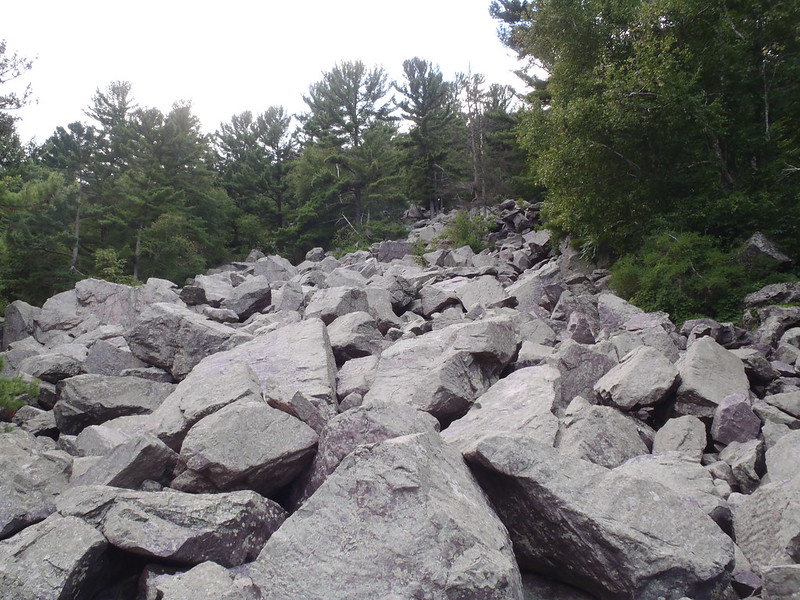
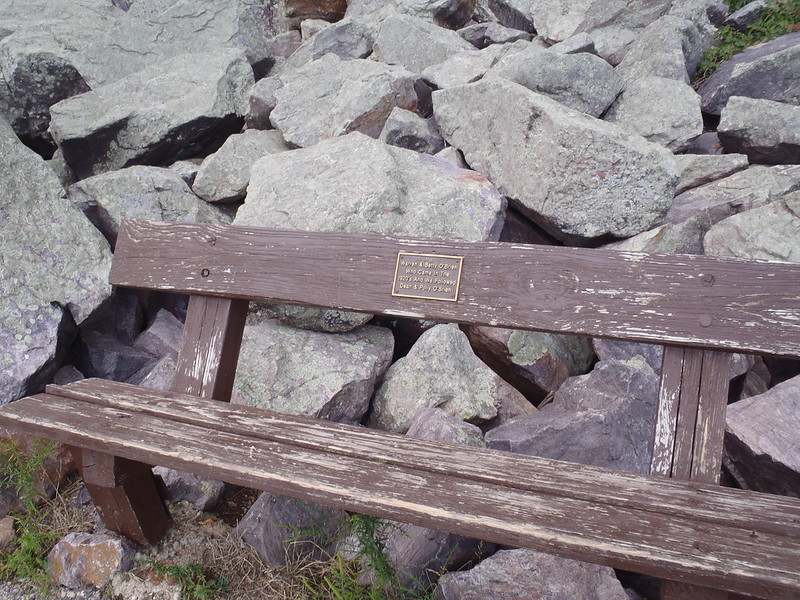
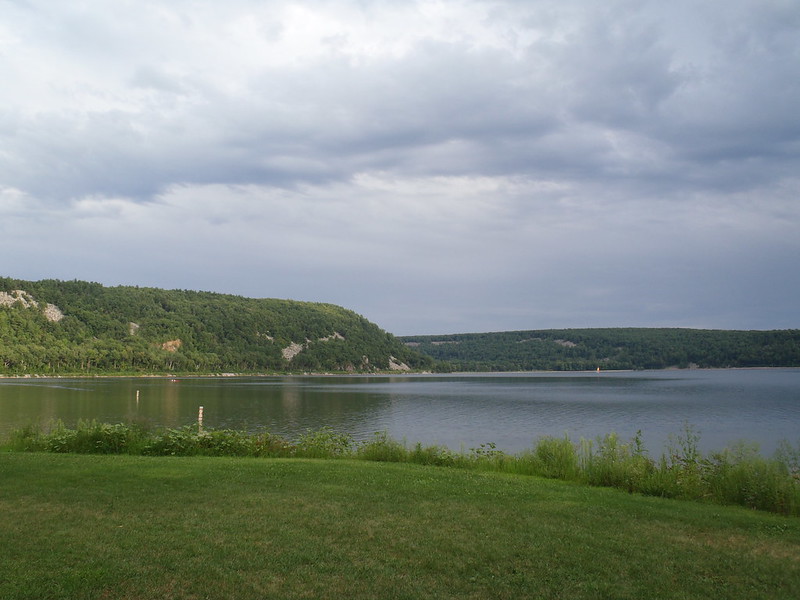
And so we set out on the long drive home, with a rainbow to guide us for about 20 to 30 minutes. In Janesville we picked up subs at a Stop n Go and dined al fresco in a pavilion under the stars at the Janesville visitors center.
And so home after a long, wonderful, and memorable day, from cranes to Ducks.
Wisconsin: Ducks, cranes, and devils
Milwaukee County Zoo, Boerner Botanical Gardens, falconry
Going to the (Milwaukee County) zoo zoo zoo
August 13th trip to Milwaukee County Zoo and Boerner Botanical Gardens.

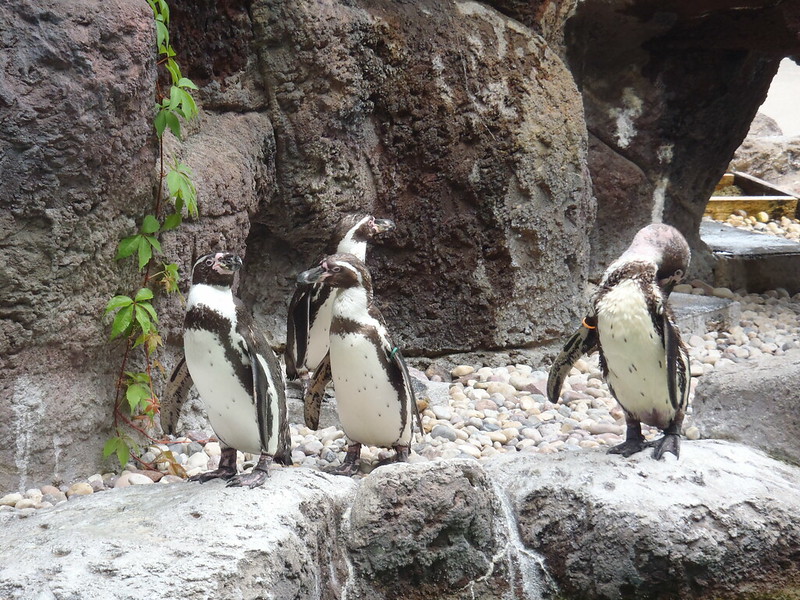
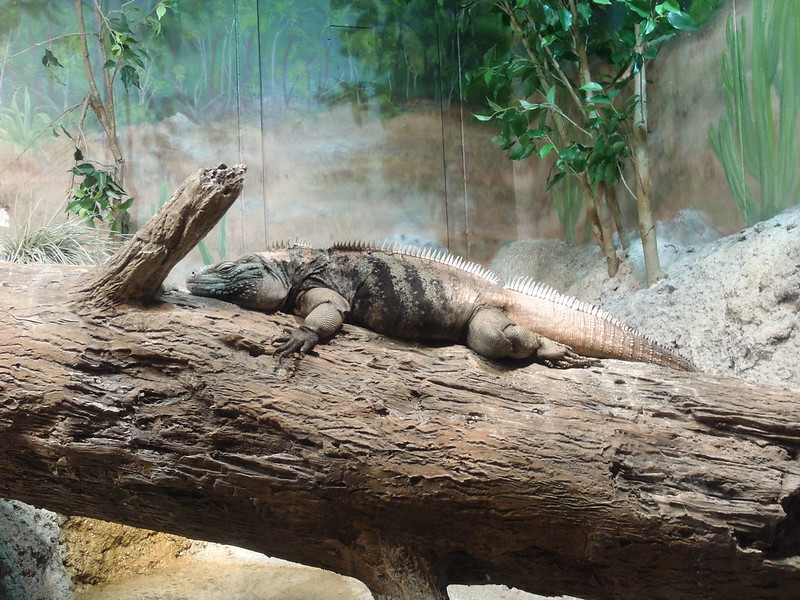
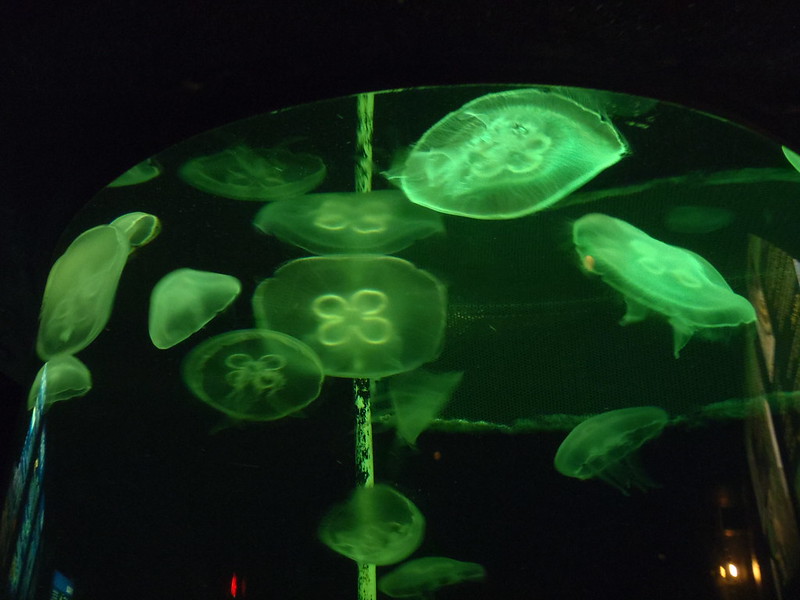
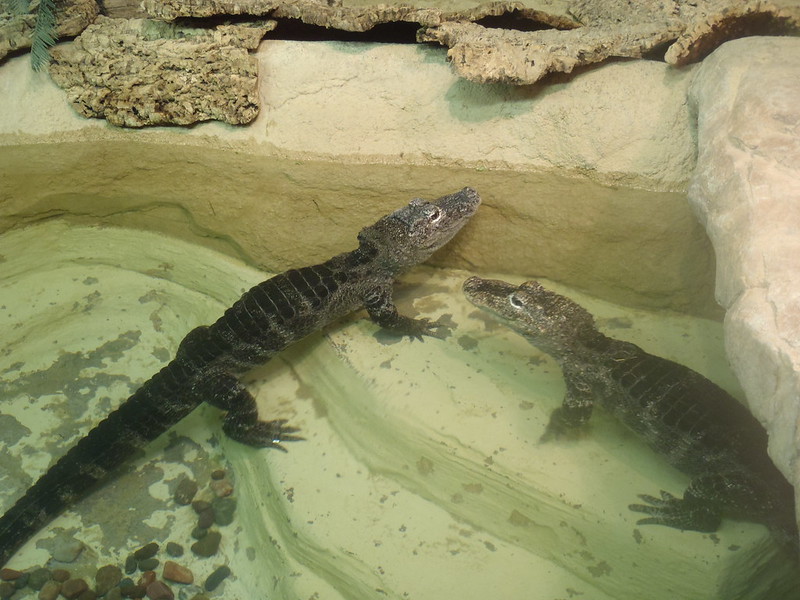

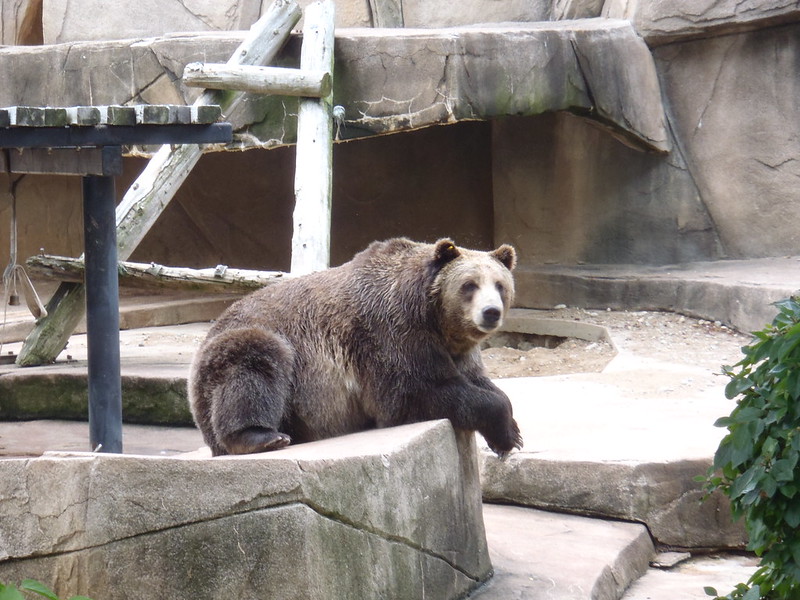
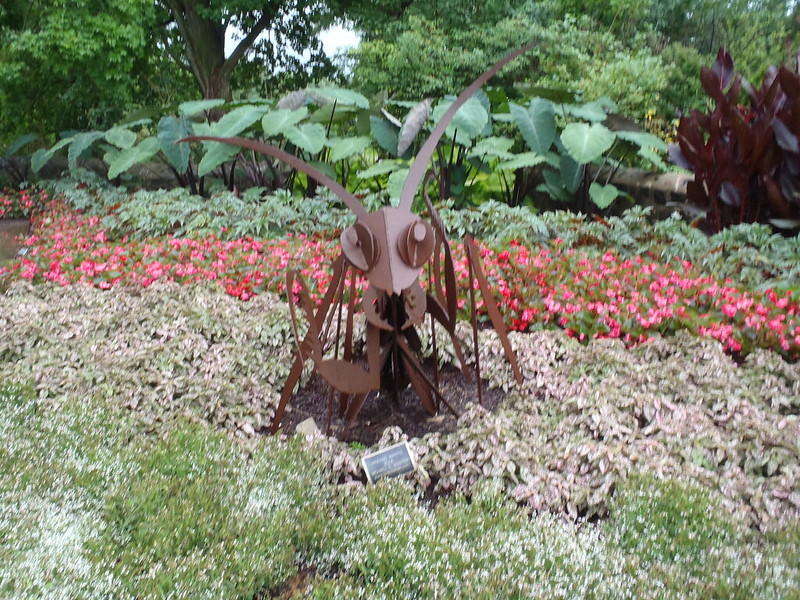

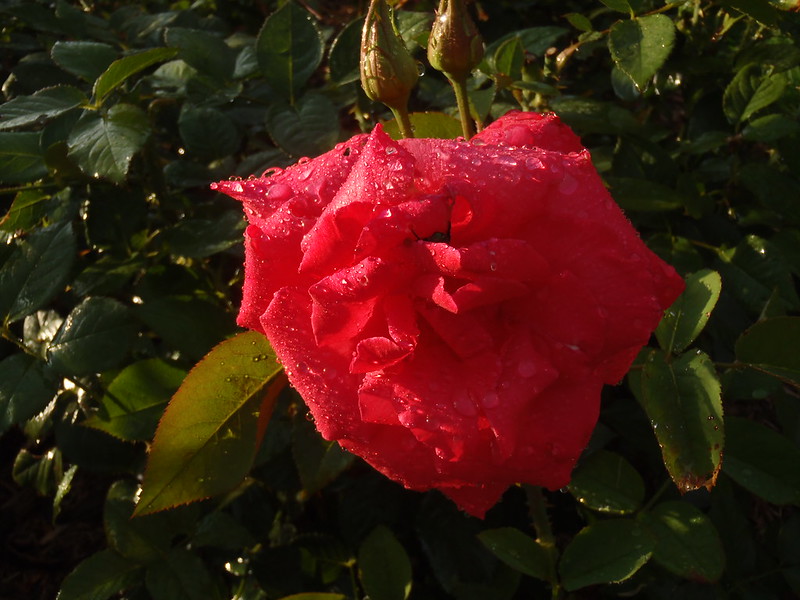
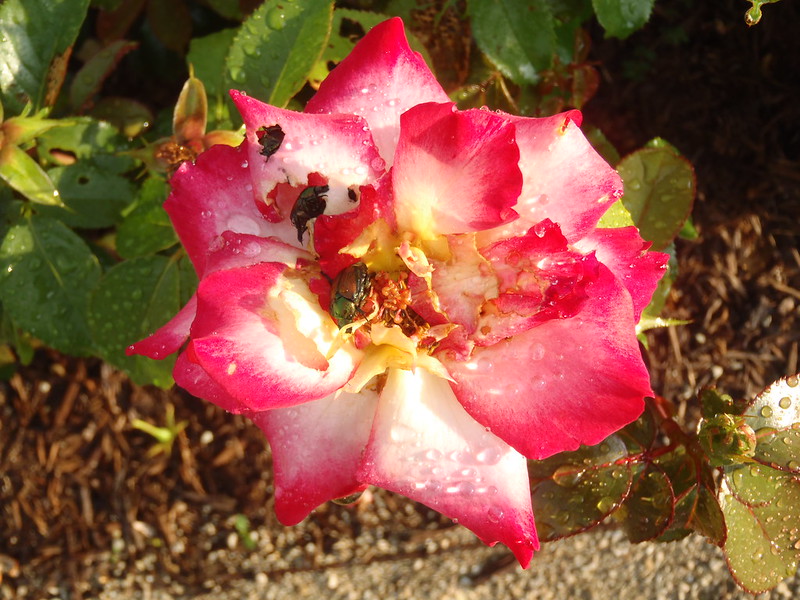
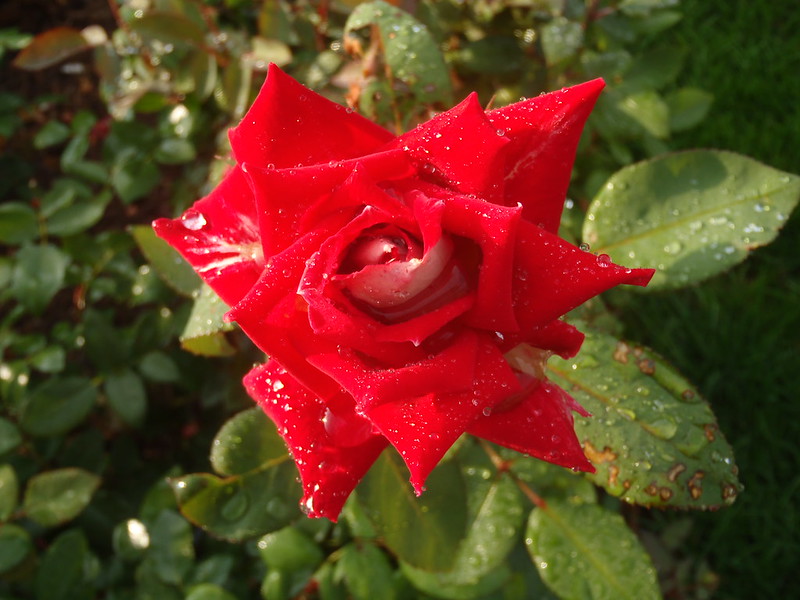
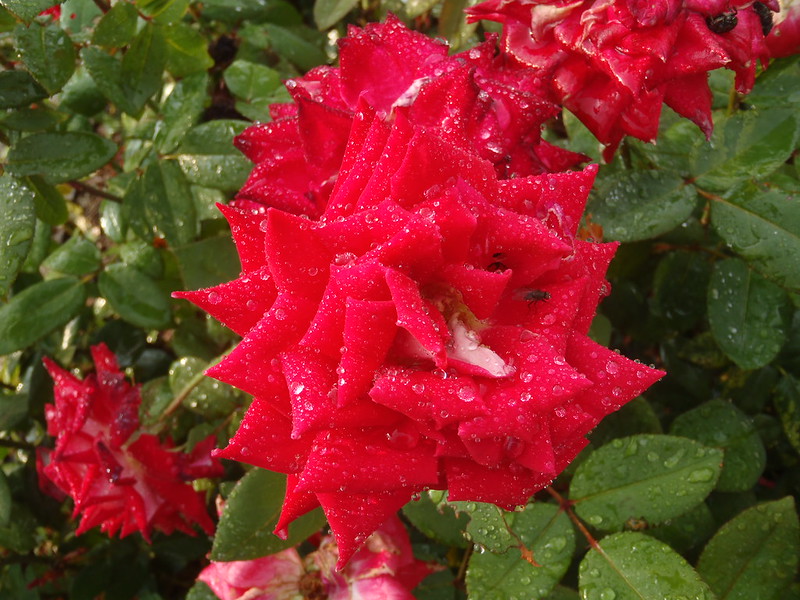
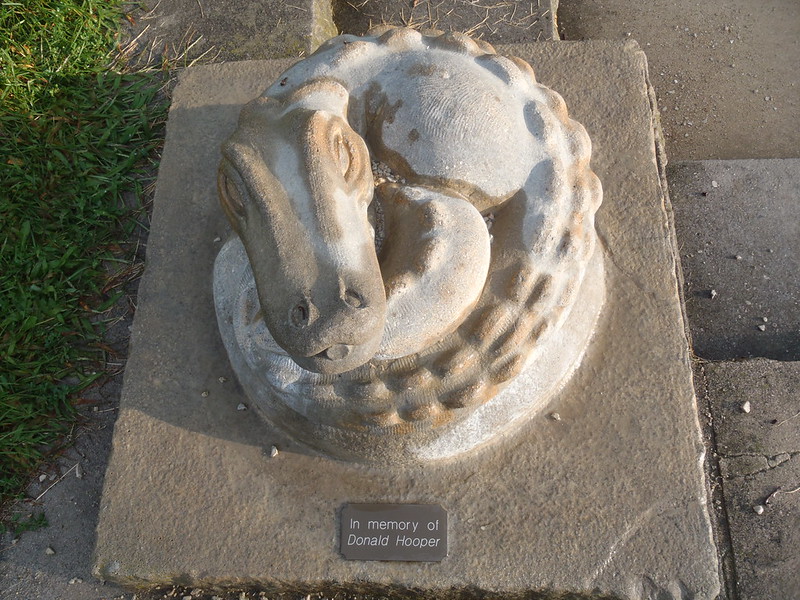

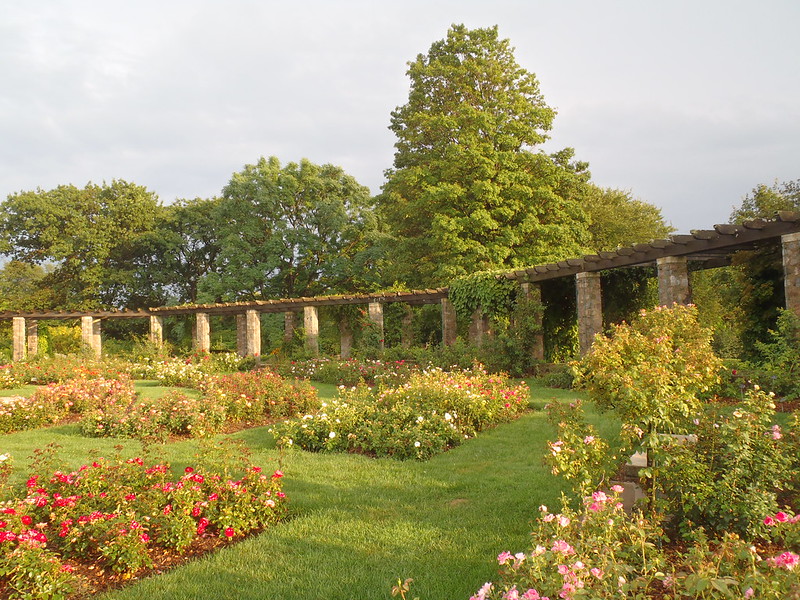

Take me to the faire
Work and weather permitting, J. and I set out for Bristol Renaissance Faire after a stop at Bonjour. This time we ended up on 41 in lieu of the Tri-State, which (1) didn’t slow us down as much as I would have thought, (2) J. found a less tense drive, and (3) didn’t cost anything. Because we were earlier than usual, we went to Apple Holler first, where a sign announced that there were a couple of days until apple picking began. A woman behind us seemed incredulous that picking would start so early, but one of the young women assured her that these are a small, tart variety (presumably for cooking). She seemed to accept that explanation somewhat grudgingly. And they call Missouri the “Show Me” state.
Both of us ate about one third of our lunches, by which time the sun seemed out to stay. At the faire, we scored the last of the front row bench seats for Adam Winrich’s fire whips show. and afterward J. picked up tips from a professional insulter while I explored the Black Pearl. We didn’t plan or do anything in particular, or at least I didn’t. J. bought memberships to Friends of the Faire, and we were given a tour of the garden. Nice group. We were told they have quite the appetites.
I decided Highland Park would be a good stopping point and discovered that it’s the home of Bluegrass (a restaurant), where I’d been been once before earlier this year.
When I opened the car door in the parking lot, I heard what sounded like hissing coming from the car. That’s one of the problems with hearing loss; the angle and distance of a sound changes its character dramatically. Even as I asked J. what the sound was, thinking it was a leaking tire, I got out and realized it was the deafening song (whine) of many, many cicadas, or dogday harvestflies. They sing in the evening here, too, but not in such quantity over such a sustained time. On facebook, Morton Arboretum had asked something like: “Cicadas — sweet sound of summer or really annoying?” Not surprisingly, the answers were divided. My guess is that your response depends on the density and volume of your resident cicada population. Hyde Park: Sweet sound of summer. Highland Park: Really annoying.
Bluegrass can be crowded and noisy, and I adore dining al fresco, so without thinking I’d opted to sit outside to enjoy the cicada chorus in the twilight. Their song wasn’t as intrusive as the din indoors. What I hadn’t considered — I don’t know why — was the army of other six-legged creatures that couldn’t leave us alone, including mosquitoes, gnats, and flies. I retrieved some spray from the car, which staved off some but not all. Poor J.
He went with barbecued bison ribs, while I ordered ribeye (rare) with bleu cheese crust. Mmmm. More leftovers.
At the Flamingo, I watched the Doctor Who episode, “The Waters of Mars.” Afterward, I realized, I needed a drink and a shower. Both made me nervous.
Labor Day free beatings
Summer’s heat has dissipated, and now a few more trees have joined my beloved but ill horse chestnut (brown from a fungal infection) in deviating from the deep greens of summer. It’s been a subtle change, but lighter greens, yellows, and other shades are starting to appear, and the young maples by the parking lot have already dropped most of their leaves, leaving them even more bare than the poor horse chestnut.
If that were not enough to herald summer’s end, there was this poor dead dragonfly, forever grounded.
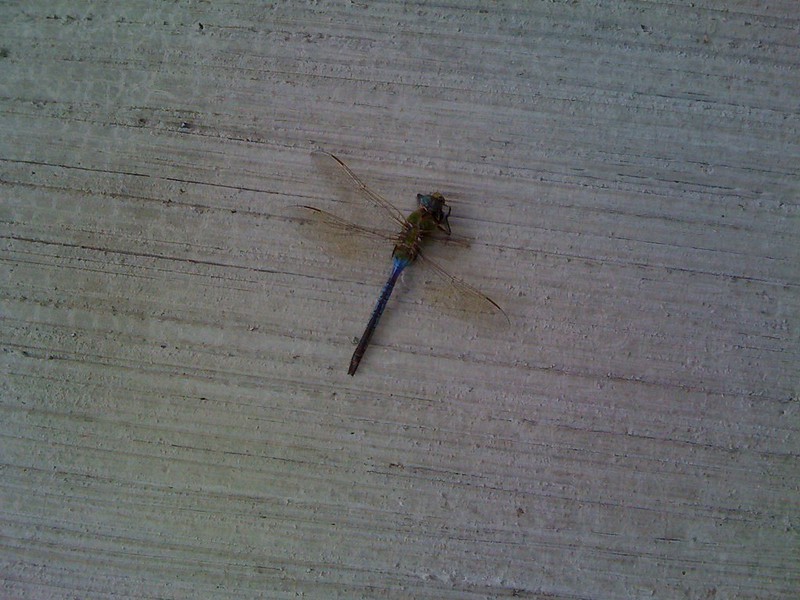
On the first, JT and I went to Lookingglass Theatre for Lookingglass Alice. I didn’t know what to expect, but it was as charming as the cast of five plus crew could make it, with appearances by many of Lewis Carroll’s dodgy characters and by a stuttering nebbish named Charles Dodgson. Although the parlor seemed conventionally Victorian, the rabbit hole was an acrobat’s hoop, and so a modernized, yet true evening of Alice began. By the end, the little girl who chides her stuffed animals seems to have been transformed into a young woman — a transformation that seems more melancholic than joyful. As with Anne of Green Gables, I’m reminded of Samuel Clemens’ admonition in Tom Sawyer: “So endeth this chronicle. It being strictly a history of a BOY, it must stop here; the story could not go much further without becoming the history of a MAN.” To me, the history of children, with their lives and unknown and limitless possibilities before them, can seem more interesting than the story of adults in whom, whatever else may be unique about them, we recognize too much of what we have become — a known, familiar entity.
After J. returned from his eventful trip, we went to Bristol Renaissance Faire Sunday and Monday of Labor Day weekend. The first day’s clouds spat drops of rain at us randomly in defiance of my assurance that rain wasn’t in the forecast. I bought CDs to add to the collection I already don’t listen to and a DVD to replace the VHS version of The Adventures of Robin Hood. We watched some of the games, then checked out the Black Pearl (jewelry), where I wistfully thought about how much I’d already spent and the fact I don’t need more earrings. Still . . .
On the way out, we passed a costumed young woman saying, “Does no one want to deflower this girl?” (presumably a flower seller). I heard her; J. did not.
We made a mad dash to Apple Holler to get there before the 7:30 closing — and just made it. Rose took a shine to us, or seemed to, and strongly suggested we ask for one of her tables the next day.
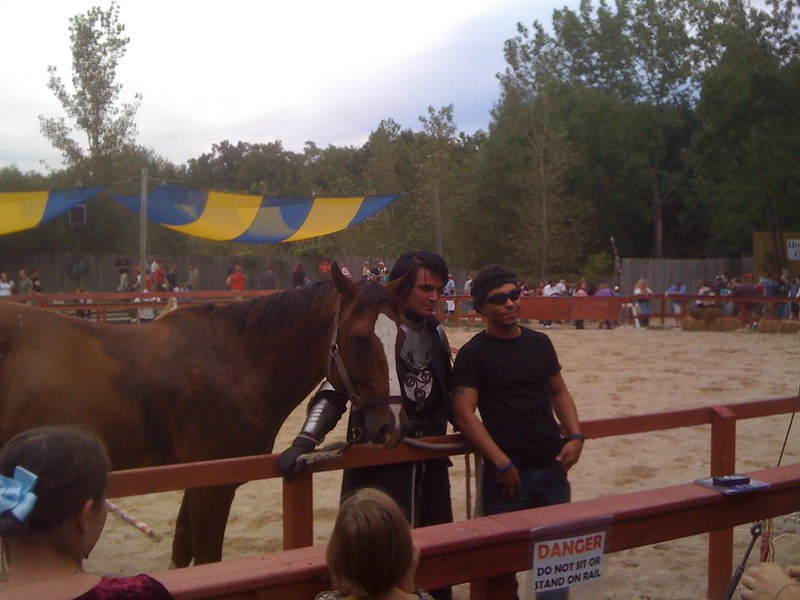
On Labor Day, we set out a little earlier, arriving in time for the joust. I lost J., who was off buying pretzels, so I sat on the ground by the fence among the children — the only spot left. He arrived later and kept walking around. As seems to be my lot, I found myself in the section whose champion was the evil knight, Sir Morrick (sp.?) of Saxony. Even if he had not insulted us as “putrid sacks of meat,” we’d have known he was evil from the vivid purple scar running down his cheek from his eye and from his jet-black hair.
While Sir Maximillian couldn’t stay focused on the games (“I’m flirting with the queen!”), Sir Morrick won them, growing more unsportsmanlike and belligerent with each one until he slugged his squire, drawing blood from her face. (Maybe he was trying to give her a matching scar.) As I told J. later, I went to a joust, and a World Wrestling Federation bout broke out. The upshot was proclamation of a “joust to the death,” to be held later in the afternoon. Despite his vile loathsomeness (handsomely packaged though it be), Sir Morrick posed patiently for photos with fans after he returned to cool off his horse. Maybe he’s not such a bad guy after all.
Ray Pena and his raptors were next — a pair of adult Harris hawks and 3-1/2-month-old gyrfalcons. He also called out his 11-year-old pointer, who seemed loath to leave the shade of the pavilion, but finally plopped in the dust of the arena. It’s hard to picture her hot on the trail of prey.
If I remember right, a kestrel demonstrated mantling, which was a crowd pleaser. Pena explained, then demonstrated, the differences between hawks (slow flyers, catching prey on the ground) and falcons (fast flyers, catching prey on the wing). The female hawk caught the lure, while the male, as Pena said, “watched like a hawk.” The falcons were fabulous, swiftly diving at the lure and somehow not catching it on the first few attempts. Once rewarded, hawks and falcons tore voraciously into their freshly thawed meat, so it was amusing to watch Pena and his assistant smoothly but cautiously slipping the hoods back onto the highly aroused birds.
After watching the sledgehammer strength game, in which a thin, wiry man outperformed his brawnier predecessors, we returned to the Black Pearl, although I was just as determined not to buy anything — until I saw the sugilite earrings.
As she was fond of purple and intrigued by anything uncommon, my aunt Marietta loved sugilite. Once when the Library of Congress was closed to all except researchers, she went in to look up what little published information there was on sugilite. Among her gemstone necklaces she had one or two of sugilite, although it’s pricey as these things go. I couldn’t help myself — I bought a pair as a tribute to her. They were relatively inexpensive because they’re veined with copper and aren’t beautifully translucent, but they are a rich pinkish purple.
As we crossed the boardwalk bridge over the turtle pond, a young woman with a scourge offered “FREE BEATINGS!” to passersby. J. didn’t notice her, either.
After a cloudy start, the day had turned perfect, and so it was a lovely end to the faire (except for the loser of the joust to the death, presumably). Rose claimed us in the queue at Apple Holler, where we satisfied ourselves with more apple-themed food.
And so back to the free beatings so generously provided in the contemporary world.
Bristol Renaissance Faire
Refreshed after a full day and night at work, J. wanted to head up to Bristol Renaissance Faire on August 22. After a haircut and a stop at Istria Café, we set out a little after two o’clock. The traffic imps smiled upon us the whole way, except for a short snarl around the Loop. It’s often been such a bad drive that I forget how easy it can be, too.
Once there, we picked up the note cards he’d ordered, then wandered around more or less aimlessly. Work and lack of sleep have drained him, while my only excuse is what had become Chicago’s 9th hottest recorded summer. nothing enervates me like heat and humidity.
I thought we might see something at the lists, but at the moment the event was the melee, during which children (including some children of adult age) take on some official defenders, using padded weapons. When the defender touches you, you run back to the line and give your weapon to the next person. It looks fun — I suppose the kids are wise enough to enjoy the game more than mind the heat. I suspect the kids nearly always win — their numbers are always greater, and perhaps the odds are stacked in other ways.
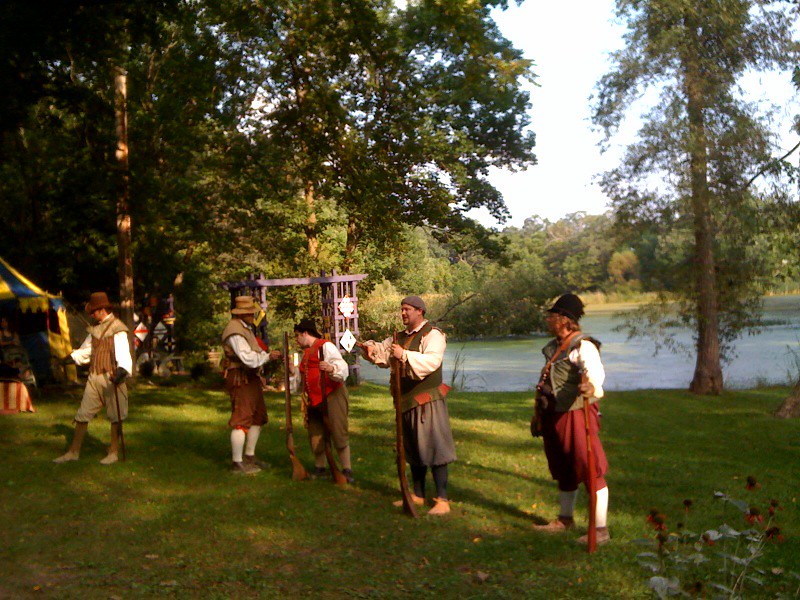
We were sitting (my idea), and I was admiring the view of a pond and a great bird — a heron? — flying over it when a handful of costumed men appeared and fired their muzzle loaders. We hadn’t seen them before, so we drew nearer to listen. One of them explained the evolution of the muzzle loader, beginning with a manually fired stick contraption stuffed with missiles like pottery fragments. Its main purpose was to induce “shock and awe,” but neither lasted long as people realized that they didn’t do much damage. He talked about the mechanism and the various improvements and calibers. Fortunately for the heron-like bird (“and your carriages parked yonder”), they fired only cloth. Both rounds were very loud, except for the second gun, which misfired the second time. These weapons are not noted for velocity, range, or accuracy, although the real point was to be able to pierce plate armor at a little distance. It made me think of an episode of How the West Was Won, in which a party discovers a Confederate soldier who doesn’t know the war is over. If I remember right, one of his weapons is a muzzle loader. They are impressed by the speed with which he can reload, and they count the seconds between rounds as they pinpoint his location and surround him — but not before he has killed one or two of them.
As we wandered and shopped and checked out the entertainment, we saw a young woman taking a photo of a very buxom friend in the typical bosom-enhancing costume. She hesitated, then said, “I don’t need a zoom lens for THAT!”
Although cooler than the previous day, the afternoon was warm and so humid that I noticed that one man’s calves were soaked in sweat. Just as we were getting ready to make our final round and leave, about an hour before sunset, I noticed that the air suddenly felt fresher, almost bearable. It was the first sign of an autumnal turn in the weather.
As we usually do, we went north to Apple Holler. This part of Wisconsin strikes me as a strange place. The faire is in a wooded area with ponds; much of why I like going to it is for the feeling the area gives me, of trees and sun and summer and even the past, my past. A little north and across the way, a stack belched white smoke at a furious rate, forming an enormous low-lying plume in the still evening air, while to our left, the sun was painting the sky many subtle shades of pink, purple, and blue over the fields and pastures. Indeed, I90/94 cuts like a scar through what otherwise would seem to be bucolic countryside, attracting box stores and chain restaurants. Even parts of the frontage road feels like a world away, although you can still hear and see the expressway’s relentless traffic.
Not far from the exit for Apple Holler, I noticed a billboard for another restaurant four miles further on and wondered if it’s been there for awhile or is new competition.
If so, Apple Holler seems not to have suffered. After we fed the “sweet” goats, as J. calls them — even the big billies who bully the smaller nannies and young ones with their bulk and horns — and did a little shopping, we found the restaurant nearly full 45 minutes before closing, with a table for 10 forming the queue in front of me. We had a good dinner complemented by flavored apple cider, then came out to find a couple of the goats on their bridge, silhouetted against the deepening evening sky. The air really did seem to have freshened — the first hint of autumn to come.
And so home for me, and back to work for him. Yes, work. Overnight. It’s beyond my understanding.
Fair(e) fight
At Bristol Renaissance Faire on Saturday, J. and I came upon these two combatants. The objective is to be the first to pop the balloon on the helmet of your opponent. The smaller of this pairing appeared to be two to four inches shorter than the larger, who, we thought, would win in short order (so to speak).
To our surprise, the tiny knight not only was the victor in both duels we watched, but he won them relatively quickly by taking an active, aggressive approach to the bigger but more defensive knight, whose strategy seemed to be to hold his sword up as much as possible to protect the balloon — unsuccessfully, as it turned out.
The match over, they removed their borrowed armor and gear — which is when we realized, to our great surprise and bemusement, the wee winner was a little girl, and the defeated enemy apparently her older brother. Now that I see the photo I notice the girlish white flip flops. Neither the boy nor the girl spoke, but he seemed ready to move on to the next amusement, while the girl couldn’t wipe the ear-to-ear smirk off her face. Truly a Kodak moment I hope she remembers forever.

